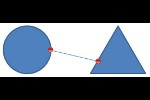Have you seen a running stitch effect around an object -- especially an embroidered one? Look at Figure 1 below to understand what we are referring to. It's possible to replicate this effect for most shapes within PowerPoint, as you will learn in this tutorial.

Figure 1: Embroidered dashed line
- Add a new slide to any existing presentation, or just create a new presentation. Make sure that it uses either the Title Only or Blank slide layout (learn how to change slide layouts).
- Insert a shape on your slide. We placed a Teardrop shape, as shown in Figure 2.

Figure 2: Teardrop shape inserted on slide
- Now, select the Teardrop, and press the Ctrl+D (Command+D on Mac) key combination twice to create two duplicate copies of the shape -- for more information, see Duplicate Shapes on our glossary pages. PowerPoint places the duplicated shapes over the original Teardrop shape -- nudge or move the duplicated shapes rightward and place them one after the other, next to the original Teardrop shape, as shown in Figure 3.

Figure 3: Duplicated Teardrops moved towards the right of the original Teardrop
- Now, resize the duplicated Teardrop shapes to make them proportionately smaller than the original Teardrop. Our original Teardop was 3 inches tall and 3 inches wide. We resized the second Teardrop to 2.5 inches by 2.5 inches -- and the third Teardrop was similarly resized to 2 inches by 2 inches (see Figure 4). Let's call these Teardrop shapes A, B, and C, as shown in Figure 4 below.

Figure 4: Resized Teardrop shapes
- Once the shapes are resized, make these changes to the fills and outlines:
- Apply a solid fill color. We chose a red fill and removed the outline of the shape.
- Opt for a no fill option. We also changed the outline color to a lighter green, and added a dash style.
- Apply a picture fill and remove the outline.
Figure 5 shows the three Teardrops, with the changes applied.

Figure 5: Teardrop shapes with different fill and outline attributes applied
- Select all the three Teardrop shapes, and align them to middle and center. Possibly, the smaller shapes could be hidden behind the larger shape, as shown in Figure 6.

Figure 6: Teardrop shapes aligned to the middle and center
- To get the shapes in the back to front order -- starting with the largest shape behind all other shapes, and the smallest shape in the topmost position, re-order them as shown in in Figure 7.

Figure 7: Teardrop shapes re-ordered
- You have now created a graphic with an embroidered dashed line border. Select all the shapes, and group them. Save your presentation.
Tip: Try using different
shapes other than the Teardrop -- you can use any of the Ovals, Rectangles and other shapes to create graphics. You can also
combine multiple shapes -- use different PowerPoint shapes to create your own graphics!
Below, you can see some graphics created using the procedures explained in this tutorial:

Hearts combined to create a grouped object

A picture within a dashed border, that's placed again within another shape

You can also use the dashed border trick with vector objects













